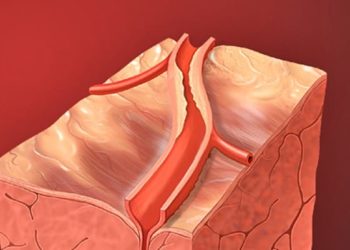Dual-energy CT may improve detection of acute small bowel ischemia
1. The use of dual-energy computed tomography (CT) significantly improved the conspicuity of hypoperfused bowel segments relative to healthy adjacent tissue in a swine model of acute small bowel ischemia.
Evidence Rating Level: 3 (Average)
Study Rundown: Early detection of acute bowel ischemia is of critical importance as mortality is significantly reduced with rapid surgical intervention. However, clinical signs and symptoms may be nonspecific, and decreased bowel wall enhancement—an early and highly specific finding on contrast-enhanced CT imaging—is less sensitive than late findings, such as pneumatosis intestinalis, bowel wall thickening, or mesenteric stranding. Dual-energy CT is an emerging CT technique that uses the simultaneous delivery of energy from separate sources and of different intensities to generate images with substantially improved contrast resolution. Among the myriad possible applications, dual-energy CT may allow for increased sensitivity for the detection of decreased perfusion. Using a swine model of surgically-induced early small bowel ischemia, the current study sought to determine if dual-energy CT could improve the diagnostic yield of imaging in the evaluation of ischemic small bowel in comparison to conventional contrast-enhanced CT. A significant increase in the attenuation difference between perfused and ischemic bowel segments was found when comparing the two techniques, with ischemic segments appearing more conspicuous on dual-energy images with an improved contrast-to-noise ratio when compared to conventional methods. The study was limited in power, potentially failing to detect more subtle differences between various beam strengths, and its clinical applicability was limited as it was performed using an experimental animal model. The presented findings are nonetheless promising and warrant further comparison of the two imaging modalities in human subjects.
Click to read the study in Radiology
Relevant Reading: Increased unenhanced bowel-wall attenuation at multidetector CT is highly specific of ischemia complicating small-bowel obstruction
In-Depth [animal study]: Four swine subjects underwent surgical induction of small bowel ischemia in two bowel segments in opposite abdominal quadrants, with confirmation of ischemia by direct Doppler ultrasound examination. Immediately following surgery, subjects were infused with iodine-containing contrast material, placed in a single-source, rapid switching dual-energy CT scanner, and imaged during the portal venous phase. Images were acquired with both a conventional 120-kVp beam and in an 80- and 140-kVp dual-energy mode, with monoenergetic and iodine material density images generated at 51, 65, and 70 keV from the dual energy data. The 51 keV reformats showed the greatest attenuation of iodine-containing contrast, as this beam energy approaches the K-edge of iodine, maximizing photoelectric excitation. The mean attenuation difference between perfused and ischemic bowel segments was greatest when comparing the 51 keV images to those acquired with a conventional 120-kVp beam (91.7 HU vs. 47.6 HU; P<0.0001), and the contrast-to-noise ratio was greatest as well (4.9 vs. 2.1; P<0.0001), denoting an improvement in conspicuity between perfused and ischemic segments. There was no significant attenuation difference between the conventional CT acquisition and the 65 or 70 keV reformats (P=0.15 and P=0.45, respectively).
More from this author: Pancreatic cancer screening with MRI may benefit high-risk patients, Quantitative MRI may differentiate true from pseudoprogression in glioblastoma, MR lymphangiography useful for evaluation of central lymphatic pathology
Image: PD
©2014 2 Minute Medicine, Inc. All rights reserved. No works may be reproduced without expressed written consent from 2 Minute Medicine, Inc. No article should be construed as medical advice and is not intended as such by the authors, editors, staff or by 2 Minute Medicine, Inc.









